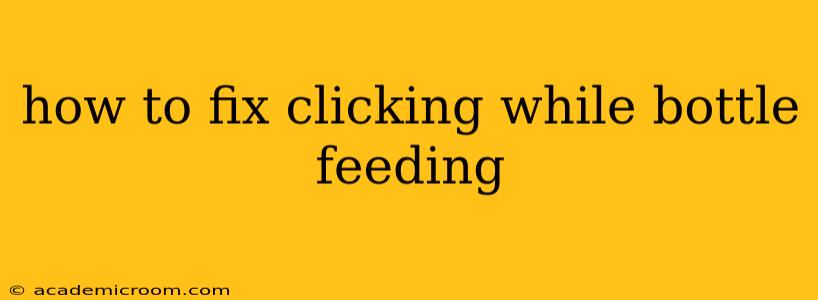Clicking sounds during bottle feeding can be alarming for parents, but often stem from simple, easily fixable issues. This guide explores common causes and offers practical solutions to ensure a smooth and comfortable feeding experience for both you and your baby.
Why Does My Baby Make Clicking Noises While Bottle Feeding?
This is a common question among new parents. The clicking sound usually originates from one of the following:
- Air Bubbles: The most frequent culprit is air trapped in the bottle nipple or baby's mouth. As your baby sucks, these bubbles create a clicking or popping sound.
- Improper Nipple Flow: A nipple with too slow or too fast a flow can lead to your baby struggling to get milk, resulting in frustrated sucking and clicking noises.
- Poor Latch: If your baby isn't latched onto the nipple correctly, they might be creating extra suction and causing a clicking sound. This can also lead to swallowing air and potential discomfort.
- Nipple Hole Size: A nipple hole that is too small will force your baby to work harder, leading to clicking and potentially frustration. Conversely, a hole that’s too large might lead to a forceful flow causing choking or spitting up.
- Baby's Fatigue or Fussiness: A tired or fussy baby may suck less effectively, leading to inconsistent sucking and the clicking sound.
How to Prevent Clicking During Bottle Feeding
Let's tackle the most common causes and offer solutions:
1. Eliminating Air Bubbles:
- Proper Bottle Preparation: Before feeding, gently swirl the bottle to mix the formula or breast milk and help release any trapped air. Avoid shaking vigorously, as this can introduce excessive air bubbles.
- Angle the Bottle: Hold the bottle at an angle, keeping the nipple filled with liquid to minimize air intake. The nipple should always be mostly full.
- Frequent Burping: Burp your baby frequently during the feeding, especially when you notice clicking. This helps release any swallowed air.
2. Choosing the Right Nipple Flow Rate:
- Match the Flow to Your Baby's Age and Development: Different nipples offer different flow rates (slow, medium, fast). Consult your pediatrician or follow the manufacturer's recommendations for appropriate flow rates based on your baby's age and development. Experimentation may be necessary.
- Observe Your Baby's Feeding Pattern: If your baby is gulping, pulling away frequently, or struggling, the flow may be too slow. If your baby is choking or spitting up milk frequently, the flow may be too fast. Adjust accordingly.
3. Ensuring a Proper Latch:
- Proper Bottle Positioning: Hold the bottle so that the nipple is always full of milk and angled slightly downward. The nipple should be completely filled to avoid air entering.
- Observe Your Baby's Sucking: Pay attention to your baby's sucking pattern. A good latch involves gentle sucking and swallowing, without excessive clicking or gulping.
- Check for a Good Seal: Make sure the nipple is fully in your baby's mouth, forming a proper seal.
4. Addressing Nipple Hole Size Issues:
- Check the Nipple: Ensure the hole in the nipple is not too large or too small. If you suspect this is the issue, try a different nipple with a different flow rate or hole size. Always follow manufacturer recommendations and use nipples appropriate for your baby’s age.
- Replace Worn Nipples: Nipples wear out over time, and their holes may become enlarged, leading to increased flow. Always check and replace nipples if they show signs of wear.
5. Addressing Fatigue and Fussiness:
- Ensure your baby is rested: Feeding a tired or fussy baby can lead to difficulties in latching, which can cause clicking. If possible, soothe your baby and try to encourage more comfortable feeding. A calm environment helps too.
- Consult your pediatrician: If clicking persists despite your efforts, you should consult your pediatrician to rule out any underlying medical conditions.
By addressing these common causes, you can significantly reduce or eliminate clicking sounds during bottle feeding and ensure a more pleasant experience for both you and your baby. Remember, patience is key!
Remember to always consult your pediatrician if you have any concerns about your baby’s feeding habits or if the clicking persists despite your efforts.
